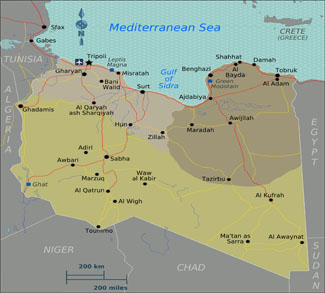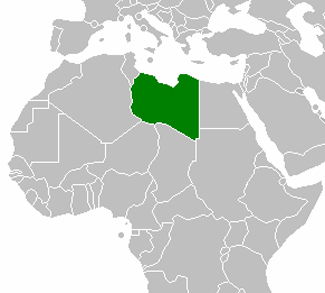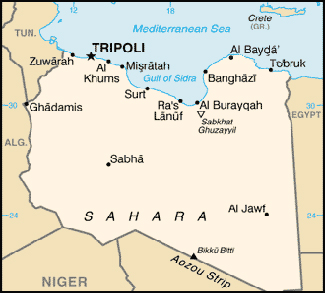In recent days, at least 43 people were killed in a series of clashes in Tripoli between armed militias from Misratah, one of the rebellion strongholds during the last days of the Qadhafi era. The militias have long ago become irrelevant to the population, responding only to power struggles with rival groups. Thousands of protesters called for the militias to leave throughout last weekend and the Tripoli City Council itself called for a general strike to challenge the militias, who responded by kidnapping – if only for a few hours – the deputy head of Libyan intelligence, Mustafa Noah. The kidnapping and clashes last weekend are again the result of the rivalry between various armed militias that have been operating in total impunity, Somalia style, since the fall of Muammar al-Qadhafi in October 2011.
The contrast with the stability of the Qadhafi era could not be more striking. These militias are for the most part tied to tribal interests – there are about 140 tribes in Libya, all calling for greater autonomy from the central government in Tripoli. During the war of 2011, these groups joined forces to defeat a common enemy in the Qadhafi regime.
Many arrived in Tripoli, took control of some neighborhoods of the city, and clashed with government forces. But their greed increased towards the end of the war, having gotten a chance to seize many weapons belonging to the regime, which were hidden in various warehouses around the country. After the fall of Qadhafi, Libya was ruled by a committee of various forces until the elections and the appointment of Prime Minister Ali Zeidan on November 14, 2012. However, the Zeidan government promptly showed weakness in its inability to extend control, let alone power, beyond Tripoli. Zeidan himself was forced to enlist the backing of some militias to create semi-official security services, which, nonetheless, failed to impose any control. In fact, Zeidan himself was kidnapped for a few hours last October.
In the prevailing anarchy, it’s not uncommon to see armed men from two rival groups challenge each other in broad daylight in downtown Tripoli, sitting on pick-ups modified with anti-aircraft weapons.
The Misratah militia is one of the best armed in the country, having had first pickings from Qadhafi’s arsenals immediately after the downfall. The situation on the streets and the rivalry between the various militias reflects clashes inside the rickety Libyan government. Secular parties seem to revolve around the Ministry of Defense (far weaker than the militias), while Islamist groups – most crucially – come under the Ministry of Interior. Who is in charge is not always clear. Parliament itself is divided along similar lines, with the Alliance of National Forces – an electoral coalition bringing together some 60 Libyan inspired political movements both moderate and secular – clashing with the political wing of the Muslim Brotherhood. The three-day strike organized by the people of Tripoli, however, may be seen as a positive sign because for the first time since the fall of Qadhafi, the people of Tripoli have joined forces to demand that the militias – hailed during the revolt – stop fighting.
The Tripoli City Council ordered the militias to abandon the city within 72 hours. There is no word on whether the call has been heeded, but it is a sign of patience running out, even if Libya continues to face the risk of breakup.
The militia battles and the kidnappings of leading Libyan intelligence figures and of the prime minister himself, however brief, have only confirmed the instability and lawlessness that persists in Libya two years after Muammar al-Qadhafi’s demise. The episode has also demonstrated the extent to which the various militias have taken control since the fall of the ‘Brother Leader.’ Qadhafi was shrewder than his antics and flamboyant robes suggested; he purposely prevented institutions from developing such as to prevent any form of alternative political process from emerging while promoting tribal competition. This has produced an inevitable scenario of total instability. The added ‘bonus’ has come from the sudden and massive presence of weapons, which has also fed conflicts beyond Libyan borders from Mali to Egypt and Syria.
The situation is further complicated by growing international indifference as the West focuses on the Syrian crisis and the quest for an agreement with Iran, which would necessitate some form of understanding over its nuclear program.
The context of the kidnapping sheds further light on the precarious Libyan government. The militias have blocked much of Libya’s oil shipments, causing a sharp drop in revenue for the government, which seems no longer able to ensure payment of salaries. This is the kind of problem that one would expect in a Sub-Saharan country such as Guinea Conakry – where soldiers protesting over non-payment of wages is a common phenomenon – rather than what was one of Africa’s richest countries until just a few years ago. In turn, the militias gain in appeal, because they appear able to guarantee some form of compensation, and power, to their members. The militias use their power to extort and blackmail. Last April, for nearly two weeks, groups of former rebels besieged the offices of the Ministries of Justice and Foreign Affairs in Tripoli by invoking the approval of the “law on political insulation” aimed at excluding officials who worked for Qadhafi in the past ten years from holding political office. Effectively, this deprived the Libyan government of some of the most experienced technocrats, further weakening state institutions.
It seems, then, that Qadhafi’s infamous eccentricities and seemingly strange decisions were the tools he used to help maintain stability. Without the iron fist of Muammar al-Qadhafi, Libya has fallen prey to the separatist tendencies of the various regions that have comprised it since the first attempt at unity was made by the Italian colonizers in the 1920’s. After the brewing troubles in Cyrenaica, the southwestern Fezzan region has unilaterally proclaimed its independence. Local tribes in the South have decided to separate because of the “weakness of General National Congress and their lack of answers to the demands of the Libyan people of Fezzan.” Tribal leaders have appointed Mohammad Nouri al-Qouizi as president of the province and announced that they would follow up by appointing regional military leaders in order to ensure the security of their border and their natural resources, which of course refers to the many millions of barrels worth of oil hiding under the Sahara. No doubt, this will prompt the central government in Tripoli to take some kind of action, perhaps using some of its new weapon systems – and ironically forcing it to act in a way that is rather reminiscent of the old dictatorship.
Last June, Cyrenaica proclaimed independence from Tripoli on the commemoration of the birth of the Emirate of Cyrenaica, which lasted from 1949 to 1951. In Benghazi, the capital, al-Ahmed al-Senoussi Zoubair, cousin of King Idris, whom Qadhafi deposed in 1969, and current leader of the Transitional Council of Cyrenaica, led the independence movement. Al-Senoussi has also announced plans to restore the Constitution of 1951, which established a clear separation of powers between the two regions. The Fezzan independence movement appears to have been inspired by the northern militias to blackmail Tripoli and use oil as a bargaining chip to obtain more privileges or to manage oil independently – Kurdistan style – of the central government. Similarly, in eastern Cyrenaica, in the city of Ajdabiya, an enigmatic leader at the head of a 17,000 men strong militia, Ibrahim al-Jathran (who became familiar with Qadhafi’s prisons, and who led a battalion of rebels against the Colonel) was ‘rewarded ‘ with the command of armed security guards at Libyan oil terminals (petroleum defense guards). Jathran has already wielded his power to block the two main terminals for oil export, demanding independence. Jathran, said the Wall Street Journal, has cost Libya more than five billion dollars in lost revenue over the past three months. Jathran has even warned that Libya has become another Afghanistan or Somalia, even as he has kept control of the self-defense of Cyrenaica force. This force is said to bring together former units of the central government and armed men in the region that extends from Sirte to Benghazi. In all, Jathran controls 17,500 men, who are paid as a much as 1,200 dinars per month (about USD 950) – no word on where the funds come from. Jathran has money and men and could become a real threat to the current Libyan government. Could he also be the one with the best solutions?
The Libyan situation is ever more reminiscent of Somalia and certainly of the former Yugoslavia. The end of a dictatorship always carries within it the seeds of territorial disintegration, especially in cases where tyranny is used to keep a country of different tribal, ethnic and interest groups together.




